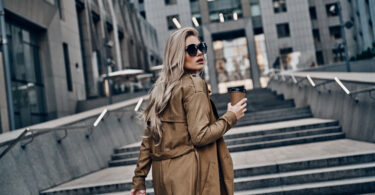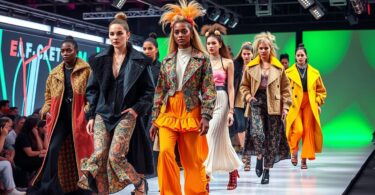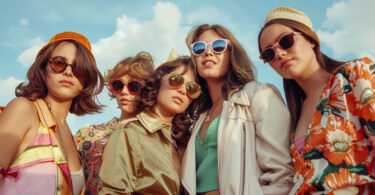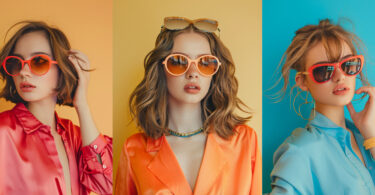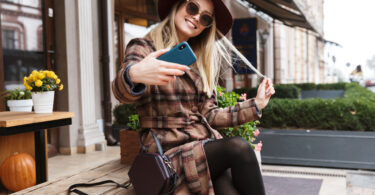The 1920s heralded a revolutionary era in fashion, characterized by an emancipation from restrictive silhouettes and a bold embrace of freedom and flamboyance. Celebrated for its elegant aesthetic, 1920s fashion serves as a profound wellspring of inspiration for women’s wardrobes even a century later.
From the iconic flapper dresses to the revolutionary dropped waistlines, the decade offered a new visual vocabulary of women’s apparel, steeped in glamour and spirited independence. This vintage charm not only mirrors the assertive styles of the 1930s fashion women glamour but also resonates with the dynamic essence of women’s 90s hip-hop fashion inspiration. An exploration of these times reveals a fascinating narrative of how fashion women’s 30s has evolved, reflecting broader social changes and the ebb and flow of style influences.
As we look back on the era, we unearth styles that have cyclically reclaimed their place within the fashion landscape, proving the abiding impact and adaptability of 1920s fashion. True to the innovative spirit of the times, today’s fashion mavens draw upon these historical precedents, distilling them through a modern lens for an allure that is as contemporary as it is classic.
Key Takeaways
- 1920s fashion is a touchstone for modern elegance, showcasing the liberated silhouettes and glamour of the era.
- The iconic flapper dress is symbolic of the 20s and continues to influence contemporary fashion.
- Fashion from this decade has cyclical appeal, with characteristics aligning with the edginess of 90s hip-hop and the sophistication of 1930s glamour.
- The intersection of historical style and modern adaptation exemplifies the timeless nature of 1920s women’s fashion.
- Understanding the social and cultural context of 1920s fashion enhances appreciation for its enduring influence and inspiration.
The Resurgence of 1920s Fashion in the Modern Wardrobe

The 1920s, renowned for its distinctive and vibrant style, continues to influence the modern fashion landscape. This era, marked by flapper dresses and extravagant embellishments, has found its echoes in the 2020s fashion, creating a blend of old glamour with new, bold expressions. Even as we look back, the influence of early 2000s fashion and styles from 1982 fashion women also show how past decades shape current trends.
Fashion is cyclical, and the resurgence of 1920s fashion elements in today’s clothing lines is a testament to its enduring appeal. Certain elements like beaded dresses and silk gloves that were popular in the 1920s have been reimagined in recent collections across major fashion houses. Moreover, the bold spirit and the push for women’s autonomy reflected in 1920s fashion resonate with current themes in fashion, linking it with the empowerment visible in the 1982 fashion women trends.
Designers today draw upon this rich history to create clothing that speaks both of comfort and luxury, much like the revolution seen in early 2000s fashion, where comfort began merging with style. This trend is visible in the incorporation of loose silhouettes and intricate handwork that are reminiscent of 1920s aesthetics yet cater to the modern consumer’s needs for versatility and practicality.
“Looking at how 2020s fashion continuously circles back to the roaring ’20s, it’s clear that the allure of that opulent and progressive time persists in modern designs, shaping how we perceive and portray elegance today,” noted a leading fashion designer during a recent interview.
- Adaptation of flapper dresses into modern mini dresses
- Use of traditional 1920s motifs like art deco in contemporary jewelry
- Reintroduction of headbands, now popular among luxury accessory lines
The echo of the 1920s in today’s fashion not only revives historical elegance but also reshapes it to fit the new-era ethos, showing a seamless blend of past and present elements that continue to enchant fashion enthusiasts around the globe.
Defining Elegance with 1920s Flapper Dresses
The 1920s fashion era, noted for its radical change and vibrant social scene, introduced the iconic flapper dress, symbolizing a revolution in women’s fashion. This liberating style contrasted sharply with the restricting garments of previous decades, offering a fresh canvas that emphasized comfort and movement while also celebrating lavish decoration. As we explore the legacy of the flapper dress, we’ll see how it not only shaped the fashion of the 1920s but also influenced casual 1950s women’s fashion and modern designs for curvy women.
The Quintessential Flapper Dress Silhouette
The quintessential flapper dress is recognized for its straight and loose-fitting silhouette, which deviated from the corseted waistlines of the past. This relaxed shape provided women with the freedom to dance the Charleston and express their independence. The typical flapper dress was often adorned with intricate beading, sequins, and layers of fringe, which animated the garment with every step.
Accessorizing Your 1920s Look: Pearls, Feathers, and Headbands
To fully embrace 1920s fashion, accessorizing was key. Long pearl necklaces, often layered and knotted, added a touch of sophistication and grace to the flapper ensemble. Feathers, either in the hair or on the dress, introduced a playful yet elegant element. The iconic headband, frequently embellished with gems and feathers, symbolized the glamorous side of flapper culture while also serving as a bold statement of the era’s opulent style.
Modern Twists on the Classic Flapper Style
Today, designers continue to draw inspiration from the flapper era, integrating its quintessential elements into modern wardrobes. Contemporary interpretations often include looser fits and adjustable designs, making it more inclusive for fashion women 30s for women curvy. The essence of the flapper dress—fringe and shimmer—remains popular in both casual and formal wear. Modern flapper-inspired dresses can transition seamlessly from a daytime casual look reminiscent of 1950s women’s fashion to an opulent evening outfit, proving the enduring appeal of the flapper dress in various sartorial contexts.
Incorporating 1920s Fashion Inspiration into Everyday Attire
Transforming daily fashion with hints of past eras, particularly the 1920s, offers a vibrant touch that echoes through subsequent decades such as the 1950s fashion, 60s fashion, and fashion 80s. This section explores practical ways to infuse the elegance and flair of the 1920s into modern wardrobes without appearing overly costume-like.
Why blend 1920s fashion into modern day looks?
The 1920s is known for its bold rebellion against the conservative styles of previous eras, introducing more comfortable yet elegant women’s attire like drop-waist dresses, which resonates with the relaxed yet chic approaches of 60s fashion. By blending these styles, one achieves a look that is both timeless and contemporary.
- Accessorizing: Start with simple accessories. A cloche hat or a beaded clutch can subtly cue the 1920s while maintaining a modern context.
- Layering: Combine a fringe jacket over a modern outfit as a nod to the 1920s passion for texture and movement, similar to dynamic elements seen in 1950s fashion and fashion 80s.
- Footwear: Incorporate T-bar pumps or wingtip oxfords, which can complement both 1920s flapper dresses and more contemporary outfits, subtly crossing over historical lines.
Contrary to the opulent and distinctive details defining 1920s attire, the 1960s introduced a more minimalistic and bold approach aligning with the modern inclination towards minimalist aesthetics. The task is to merge these varying influences into a seamlessly stylish ensemble that respects historical significance while embracing current-day relevancy.
Mixing and matching different historical elements in outfits is like telling a story where each piece adds a layer of intrigue and creativity.
Ultimately, incorporating elements of 1950s fashion, 60s fashion, and fashion 80s with inspirations from the 1920s can offer an updated take on classic styles. This integration not only celebrates the past but revitalizes it, demonstrating that fashion is not just about clothing but also about evoking a sense of personal and historical identity. It’s about making a statement with what was once revolutionary and adapting it to what is now trendy.
High Fashion Meets History: 1920s Luxury and Art Deco Influence
The roaring twenties heralded a seismic shift in the world of fashion, witnessing the dawning of an opulent era where Art Deco influence on fashion design significantly sculpted the aesthetic landscape. This period’s hallmark was its embrace of luxury, symmetry, and bold geometric patterns, all rooted in the Art Deco movement that permeated through various domains of creativity.
Art Deco and its Impact on Fashion Design
The glamorization of the 1920s can largely be attributed to Art Deco’s profound impact on fashion design. Designers incorporated exuberant shapes and intricate motifs that mirrored the era’s architectural triumphs. This stylistic confluence is not just a study in aesthetics but also a robust framework influencing successive decades like the 1980s fashion explosion, where power dressing and bold geometric prints took center stage.
Icons of 1920s Elegance: Chanel and Beyond
Coco Chanel, a name synonymous with revolutionary simplicity and elegance, rooted the ethos of comfort and sophistication that later reflected in the 70s fashion women rock spirit. Chanel’s uncluttered lines and comfortable designs contrasted sharply with the period’s typically ornate approach, forecasting a new age for women’s fashion wherein practicality met allure.
Luxe Fabrics and Ornamentation of the Era
Luxurious fabrics such as silk, satin, and velvet became canvases for the era’s artistic expression, heavily embellished with beads, sequins, and feathers. It’s the meticulous detail and craftsmanship of these materials that underscored the sumptuousness characteristic of 1920s high fashion. Such opulence seamlessly fed into the flamboyant styles that dominated the fashion narratives in later eras.

Understanding the Art Deco influence on fashion design not only gives us a window into the past but also enriches our appreciation of its enduring legacy in the tapestry of modern fashion. From runway revivals to everyday wear, the essence of the 1920s continues to ripple through time, influencing contemporary design elements and trends.
1920s Fashion Inspiration: From Silver Screen to Street Style
The allure of 1920s fashion transcends time, continuously influencing modern styles and trends. From the legendary Hollywood’s Golden Era, fashion idols introduced the masses to an unprecedented wave of elegance and sophistication. Today, the impact of these trailblazers still permeates contemporary fashion sensibilities, merging the opulence of the past with the versatile, eclectic tastes of the present.
Hollywood’s Golden Era and Fashion Idols
During Hollywood’s Golden Era, silver screen icons set fashion trends that became the epitome of glamour. The understated sophistication they embodied whisked through the wardrobes of countless admirers, setting a benchmark for elegance that still echoes in today’s high-fashion circles. The lavish gowns, tailored suits, and meticulous attention to detail of the 1920s remain integral to the DNA of red-carpet looks and 90s fashion outfits alike, proving the era’s enduring legacy.
Adapting 1920s Glamour for Today’s Fashion Forward Women
With a nod to past splendor, today’s fashion forward women often look to translate the 1920s charm into modern ensembles. Having witnessed the revival of many bygone trends in 2018 fashion trends, stylists and influencers creatively interweave the elegance of the 20s with the relaxed, more practical aesthetic prevalent in recent years. The balance of vintage with contemporary, tradition with innovation embodies the versatility of the modern fashion landscape. As a result, the quintessential flapper dress evolves, finding its stride in the form of embellished tops, beaded accessories, and even power suits with a nod to the opulence of the decade.
Reviving 1920s Trends in Contemporary Fashion
The fearless spirit of 1920s fashion is a source of inspiration for numerous designers seeking to evoke the animated vibrancy similar to 70s women’s disco fashion. This spirit, intricately woven into the fabric of 90s fashion outfits, underscores a connection across the decades that goes beyond surface aesthetics. As we delve into the rich tapestry of fashion history, the revival of 1920s styles illustrates the cyclical nature of trends and the everlasting appeal of certain epochs that continue to inspire and shape the sartorial choices of today’s fashion enthusiasts.



